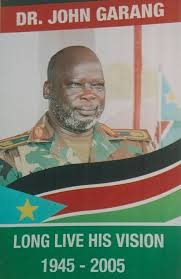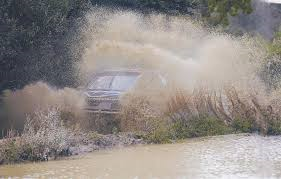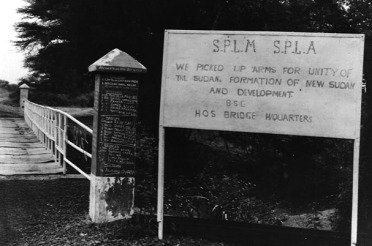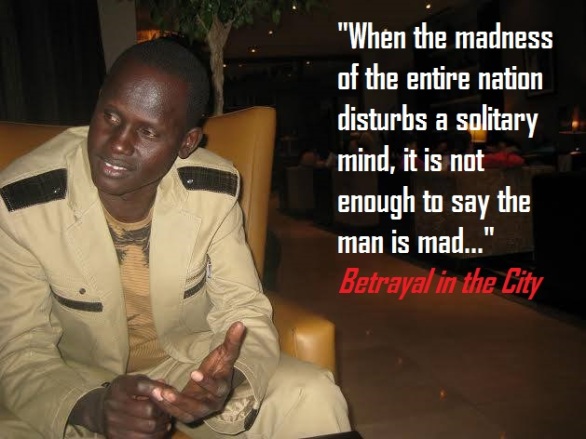PART III: THE DAY ANTI-TANK LANDMINE FAILED TO BLOW DR. JOHN INTO PIECES!
 Thanksgiving for October 9, 1988 (Part III)
Thanksgiving for October 9, 1988 (Part III)
Personal Message: To my esteemed readers, the theme of this article is thanksgiving to God, and not to impress anybody. In fact, if I knew the addresses of God and our martyrs, I would just send the letter direct to Him and them. However, since the survivors who are going to read this are also part of the struggle, so I hereby serve you with a copy in all your various social media and other addresses out there.
Miracles did not stop with Jesus in AD 6. To me as a witness, miracles happened to us on October 9, 1988. Another thanksgiving message will come on the day of another miracle like the one of today, when our president, H.E. Gen. Salva Kiir Mayardit fell down from the sky with an aeroplane near Nakuru, Kenya in 1993, and survived till he became our president today. By the way, the 9th day of the month started being for good things as associated with the Movement since the inception of the liberation project. I call it ‘good things’ because Dr. Garang did not die on that day.
Just two days after the annihilation of the ‘Lokurdek Forces’ in Ikotos as discussed in Part II two days ago (October 7), the Khartoum regime of Sadig al Mahdi continued with its promise to Lokurdek of sending more reinforcement to either kill or capture Dr. John. Having mapped the area during the Ikotos battle, the enemy descended on us from above.
Having intercepted the enemy’s evil plot to come and destroy Homa village, where the chairman commanded the Ikotos operations, the senior officers in the headquarters decided to evacuate Dr. John back to his headquarters at Hilieu. Unfortunately, all the trucks had gone after Lokurdek who was running towards Uganda. But there was only one Ural truck in the headquarters, so he used it for the relocation to Hilieu.
Fortunately, the God of the SPLA worked as usual. Our good radio operator, 2nd Lt. Akim Muorwel, intercepted the enemy’s plot of sending two Mig Fighter Jets and one Antonov, and informed the Big Man immediately. While surveying the area at Loguruny for about 20 minutes for the planned operation on Torit, we continued our journey!
Just 700 metres from Loguruny village before branching to Iloli on the way to Hilieu, ‘boom!’ We felt white hot lightning across the sky above the truck at 10 o’clock in the morning of such a day (October 9, 1988)! The Chairman’s Ural stepped on the landmine! After a short spell of darkness, those who could hear a sound were alive. And in fact all of us turned out to be alive later, except 1st Lt. Marial Nuor Jok, the head of Guards Unit (now Director of Military Intelligence in Juba) who was unconscious for 30 minutes and woke up later. Our hardworking, humble doctor, Majok Yak (currently a member of National Assembly from Twic County in Warrap State) did his best and nursed Marial. Thank God, he is alive today!
Now the miracle! As everybody rushed to check the Chairman first before coming back to check themselves, the man was found seated on his front seat of the truck the way he was! Not actually the way the truck was. The ural was in bad shape as the front glasses were smashed and thrown out. Dr. Garang was squarely curved out with the front seat, thrown up in the air and thudded back to the ground while still seated as before! The truck was dismantled badly. Everybody found themselves in the air, others on trees, others landed back into the truck, and some to an unbelievable distance away from the scene.
None died! Dr. John was not wounded save for a small scratch on his palm, what his Dinka pastoralists used to call ‘garai-ke-thon’ scratch (Bull’s Bruises just to minimize the danger of the damage). He did not tell us till we realized it later that he had a scratch bleeding on his left hand.
What puzzled us was the way the Man used to like minimizing problems, even big ones like this. Imagine him telling Deng Alor who was connected to the accident scene by radio call on the line from Kampala, “Everything is ok. Nuna kweiseen or We’re fine. We won!” he bragged. “Eh, this man, ya jamaana!” We, soldiers, wondered as their jovial conversation went on. The soldiers who were groaning from the bruises and trauma of the incident began to wonder what this man is upto. But what Dr. John actually meant in his report on that scene was the general operation, as he considered that incident an individual problem even on him as the head of the liberation movement. He also did not want to discourage other officers and the entire Movement, nor did he want to let the enemy feel one time that Dr. John is beaten.
Still wondering in the middle of nowhere, with no truck, no food, no water, no reinforcement, the nightmare was not over, yet. Marial Nuor laid in coma for a while as Machol Majur (now Major in the SPLA) and the C-in-C’s radio operator, Amat Malual, who later died with him in the 2005’s helicopter crash, were nursing their wounds. The two suffered dislocations on their hands, but were minor injuries. We were in safe hands.
Nevertheless, after six hours of wondering and wandering in confusion, Maker Ayuen Deng, the cipher officer of the radio, and Philip Chol Kander (both now diplomats in the Embassies of South Sudan in London and Nairobi, respectively) made contact with our forces who were after the fleeing enemy, and we were rescued later in the evening with the arrival of one Fiat truck. The officers could not believe what they saw. The story was also not believed by those far away from the operations area, given the capacity of the mine and the damage done.
Of course, I owe thanks to God for saving us, and particularly our liberation movement. I cannot also forget the efficiency of the machine we were using. Ural truck, made in the Ural Region of U.S.S.R (by then Union of Soviet Socialist Republic), was the strongest machine trusted for the movement of our Movement. If it were another make of trucks that we know today, Dr. John and his entire headquarters in the truck would not survive, and this story would be told by another person today.
 Therefore, my conclusion goes back to the previous parts of this piece of history. The comrades who lost their lives in the battles of Hiyala and Ikotos, as well as in so many other series of operations between 1983 and 2003, must be told that what they donated their lives for, is now called ‘The Republic of South Sudan’. As a reminder, my readers should expect other testimonies from other operations in various areas. Besides our memories, we have tangible records in form of books, video and audio cassettes, live histories from our survivors, which will be serialized here.
Therefore, my conclusion goes back to the previous parts of this piece of history. The comrades who lost their lives in the battles of Hiyala and Ikotos, as well as in so many other series of operations between 1983 and 2003, must be told that what they donated their lives for, is now called ‘The Republic of South Sudan’. As a reminder, my readers should expect other testimonies from other operations in various areas. Besides our memories, we have tangible records in form of books, video and audio cassettes, live histories from our survivors, which will be serialized here.
Long Live the Legacy of the People of South Sudan!
God bless The Republic South Sudan.
By Kur Garang Deng,
kurgarang@yahoo.com
NB: The writer is a diplomat in the Embassy of South Sudan (Kenya) and an MA of Diplomacy (IDIS) student in the University of Nairobi.




